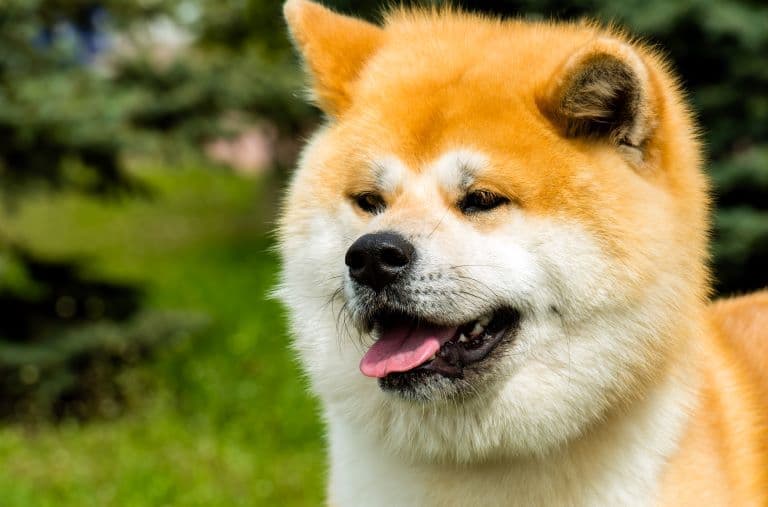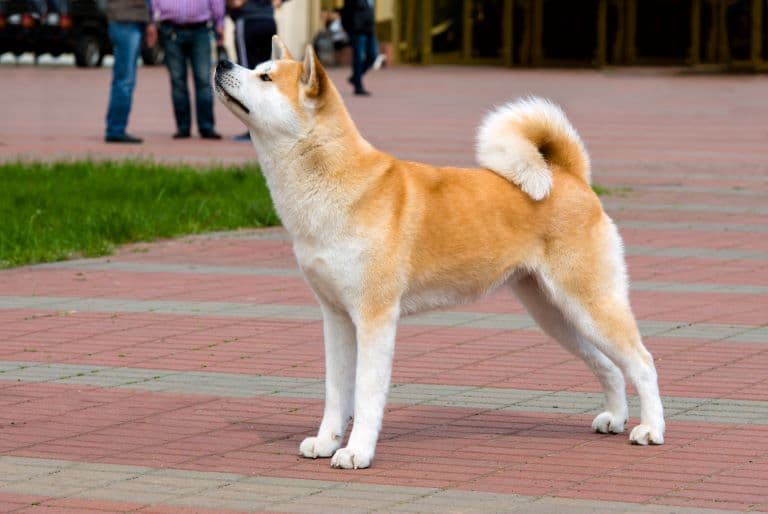Akita Profile
Described by fans as “dignified, courageous, profoundly loyal”, this is pretty much what any proud owner of a dog would say, but with these perks come some difficulties, and courageous loyalty can often result in violence in uncontrolled situations.
The Akita is another example of a beautiful animal that’s a wonder to behold in the right hands and a lethal weapon when mishandled.

Akita Facts Overview
| Habitat: | Domestic, home |
| Location: | Worldwide, from Japan |
| Lifespan: | Around 13 years |
| Size: | 70cm (28 inches) tall |
| Weight: | Up to 60kg (130lb) |
| Colour: | Grey, brown of black with white legs and belly |
| Diet: | Dog food |
| Predators: | None |
| Top Speed: | 40km/h (25mph) |
| No. of Species: | 1 |
| Conservation Status: | Not Listed |
Akitas have a long history in Japanese where their legacy approaches a level of worship. They have all the characteristics of a classic warrior: power, loyalty, aggression and dignity. So, it’s not hard to understand why they were so honoured as a breed in military cultures like those in Japan and the US.
But these traits often fare badly in safe and peaceful societies, and the Akita shows us that dogs are more than just cuddly toys that can love you back.
Interesting Akita Facts
1. They’re traditionally samurai dogs
As with most popular purebreds, the Akita has a working history that comes from Northern Japan. These dogs were bred to guard family and flock from predators, and to help in the hunting of elk, boars, and bears. They were also used commonly in dog fights and even to pull carts.
It’s said that from the day the Emperor of Japan received an Akita as a gift, he decreed that every samurai would be given one to keep. A legend emerged that if a samurai died dishonourably (outside of the way of a warrior), he might be reborn as one of the dogs and therefore be given a second chance. 1

2. Their loyalty is legendary
100 years ago, in 1923, an Akita was born whose loyalty would become infamous. 16 months later, the dog could be seen waiting patiently for his owner in Shibuya train station, as he did every day during his owner’s commute.
The dog, Hachiko, would reunite with Professor Hidesaburo Ueno every day after work, until one day, the man didn’t return.
Despite the professor’s death, the dog waited patiently at the station, day after day, becoming a welcome mascot for the blind obedience and self-destruction of the “ideal citizen” favoured by the imperial ruling classes of preceding years and woven into the ‘Greater Good’ culture of modern Japan.
For around ten years, the dog visited the station, sustained by gifts of food from locals, and after he finally died, a statue was erected in his honour.
As Japan moved toward a constitutional monarchy and party politics began to flourish, the legacy of Hachiko became a romantic worldwide symbol of love and loyalty that’s sickeningly familiar to all dog owners.
3. They’re also strong-willed
This loyalty comes with a condition, and Akitas are well known for being independent-minded and headstrong.
This makes them difficult dogs to manage for people with no experience and has led to trouble.
As with any large powerful dog, they are potentially very dangerous animals, and there have been numerous cases of attacks on people. Some sources suggest that Akitas are the third-most likely to bite a person, and with the power that comes behind such a large animal, these attacks can be deadly.
Between 1982 and 2013, there were 8 deaths and 52 maimings attributed to this breed in the US and 44 child victims of Akita bites. 2

4. They were also used to find people
Akitas are smart and hardworking dogs, with good trainability, and these attributes make them excellent scouts and hunters of people.
In various wartime contexts, Akitas were used by the Japanese to find lost prisoners, stranded sailors, or anyone else in need of capture, and this was something that helped keep them alive.
During the Second World War, an order was placed to cull all non-military dogs. Akitas became fair game for fur hats and boots, so breeders and owners began shipping them off to hide and breeding them with German shepherds so they could be claimed as guard dogs.
Later, a native breed was mixed back into the gene pool to try and restore the Akita line. 3
5. Hellen Keller brought them to the US
Helen Keller, the American author, political activist, and lecturer, is credited with bringing the Akita breed to the United States.
During her visit to Japan in 1937, she was gifted an Akita dog named Kamikaze-go, who unfortunately died at a young age due to distemper.
Touched by her love for the breed, the Japanese government later sent her another Akita, Kenzan-go. This second dog successfully made it to the United States, marking the introduction of the Akita breed to the country.
Keller was taken with the breed’s loyalty and intelligence, and her enthusiasm contributed to the Akita’s growing popularity in America. But this popularity has come at a significant cost. 4

6. They’re not for the inexperienced
Dog ownership is woefully unregulated in every country, and Akitas are a reminder that this needs to change.
Having a cuddly, four-legged person around to worship and protect you is always tempting, but the culture of pet ownership is such that people don’t realise the power they’re bringing into the home. Pets are not toys, and no matter how domesticated an animal is, it cannot ever be 100% predictable.
Akitas are immensely powerful dogs with a high capacity for aggression. The very loyalty and commitment that’s so highly praised in them is what makes them so dangerous in uncertain environments.
With high energy levels and a high exercise requirement, they’re considered unsuitable for inexperienced owners, yet there is still little applicable restriction on their ownership in the UK and most of Europe. The US, Ireland, Spain and Ukraine, on the other hand, do have restrictions, and the breed is banned in both The Bermuda Islands and Singapore. 5

Akita Fact-File Summary
Scientific Classification
| Kingdom: | Animalia |
| Phylum: | Chordata |
| Class: | Mammalia |
| Order: | Carnivora |
| Family: | Canidae |
| Genus: | Canis |
| Species: | lupus familiaris |
Fact Sources & References
- (2019), “Akita inu, the most loyal dog of Japan”, Peak Experience Japan.
- “Dog Bite Statistics – Children Are Most Likely Victims to Be Bitten by an Akita Dog”, The Law Offices of Gerald J.Noonan.
- (2023), “History of the Akita Inu: 1 of the Great Japanese Breeds”, A Dog’s Game.
- Stephanie Gibeault (2020), “Helen Keller Was a True Dog Lover”, American Kennel Club.
- (2020), “UK Favourite Dog Breeds Which Are Banned in Other Countries”, PBS Pet Travel.
